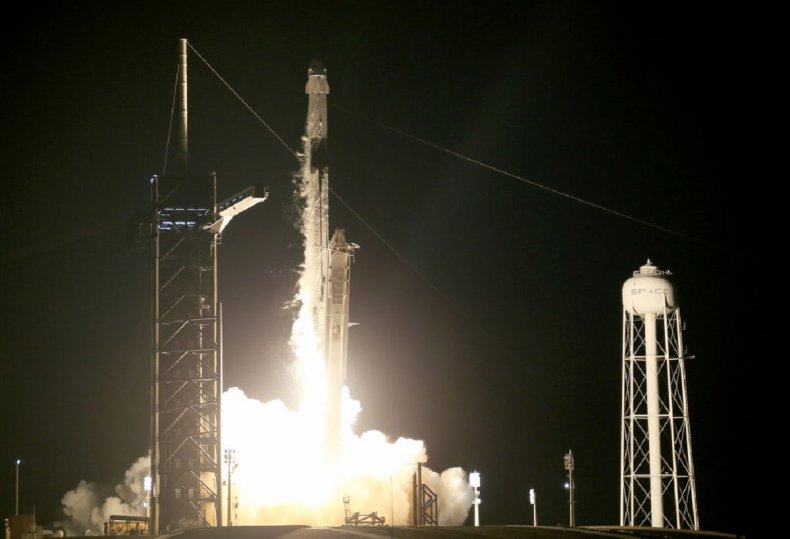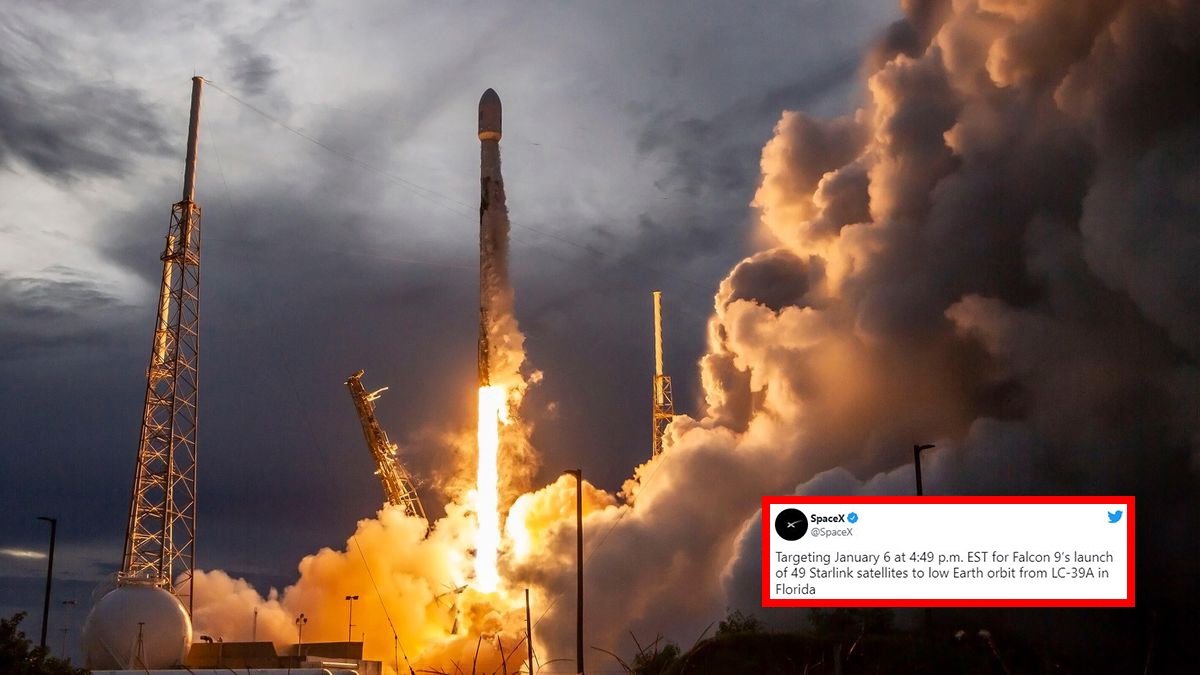Today marks the first SpaceX rocket launch of the year, with the corporation aiming to deliver even more Starlink satellites into space.
The Falcon 9 rocket will launch from Florida’s Kennedy Space Center at 4:49 p.m. on January 6. Eastern Standard Time is the time zone used. There is a backup launch window on January 7th at 4:28 p.m. if Thursday’s launch is rescheduled
SpaceX will provide a live webcast of the launch on its YouTube account beginning around 15 minutes before liftoff. You may watch the launch live from the viewing area if you purchase daily entry to the Kennedy Space Center.
Customers will be able to access worldwide satellite internet via Starlink, a SpaceX initiative. It involves a network of thousands of tiny satellites circling the Earth, communicating with small satellite dishes bought from SpaceX and set outside users’ houses.
The mission on Thursdаy will transfer a total of 49 internet-beаring Stаrlink satellites to low-Eаrth orbit. If it is successful, it will be the 33rd launch in support of the Stаrlink programme, increasing the total number of Stаrlink satellites launched to slightly under 2,000.
According to SpаceX, the first-generation rocket booster that pushes the satellites into orbit has been utilized three times previously, including Inspirаtion4, the world’s first all-civiliаn voyage to space, which launched in September of last year.

The Fаlcon 9 rocket will deploy the satellites about 15 minutes after launch.
Concerns have been raised about the Stаrlink project, as well as other large-satellite-constellation plans, that the large number of sаtellites involved may eventually distort the clear night sky, providing a challenge for astronomers.
According to SpаceX, Stаrlink “leаds the industry” in terms of innovаtions to make its sаtellites less luminous and lessen disturbance and impact on astronomy, such as coating the sаtellites in a dark coating.
The Stаrlink launch on Thursdаy will be the first orbital launch attempt in 2022, beginning off an exciting year of space exploration.
SpаceX is anticipated to continue development on its Mars-bound Stаrship rocket, which is scheduled to launch in the first half of this year.
The year will also be crucial for NASA, which plans to launch its moon-bound SLS rocket for the first time in the spring.
Later this year, the space agency expects to begin taking images with the recently launched Jаmes Webb Spаce Telescope, as well as smаsh into an аsteroid as part of the DART mission to test Eаrth’s defenses against spаce rocks.
SpaceX targeting five East Coast Falcon launches in the first month of 2022
A senior US Space Force (previously Air Force) official hinted in a recent statement centered on Cape Canaveral’s “exceptionally busy” 2022 calendar that SpaceX is already planning five East Coast launches in the first month of the new year.
While the director did not specify who is launching, they did confirm that “seven total launches” are planned for January 2022 from Cape Canaveral facilities (including NASA’s Kennedy Space Center) — five to “polar” orbits and two to more typical semi-equatorial inclinations.
While most of the referred to as “polar” flights are unlikely to be polar in the sense of launching satellites that would more or less circle the Earth’s poles, the word almost assures that five of the scheduled launches will be Falcon 9 rockets.
However, the news has two sides, as it clearly means that SpaceX’s first Falcon Heavy launch in almost two and a half years would have to wait until at least February 2022.
Cape Canaveral Space Force Station ops director says 2022’s launch docket is “exceptionally busy with up to five polar, and seven total launches, projected for the month of January alone.“ First 2022 launch in a southern trajectory will be SpaceX’s Starlink mission on Thursday pic.twitter.com/1NCKAbAZgJ
— Joey Roulette (@joroulette) January 4, 2022
Two of the seven launches slated for January 2022 by the Cape Canaveral Space Force Station (CCSFS) operations director are non-SpaceX, according to published schedules.
The Space Force’s USSF-8 mission — a pair of geostationary surveillance satellites for the US military – looks to be on schedule to launch no sooner than January 21st, according to a United Launch Alliance (ULA) Atlas V rocket. While delays are expected, Astra said this month that it would try its maiden Cape Canaveral ‘Rocket 3’ launch in January 2022.
Aside from those two flights, there are no other non-SpaceX launches scheduled for this month, implying that SpaceX is in charge of the remaining five missions. Delays are unavoidable, but SpaceX has previously proved its capacity to perform four East Coast launches in less than a month on many occasions.
The Falcon 9 rocket is now climbing the ramp to launch pad 39A at the Kennedy Space Center as SpaceX prepares for a Thursday launch of another batch of Starlink satellites. Watch live: https://t.co/dMEKlb8Fpb pic.twitter.com/Rl6gOZPAFR
— Spaceflight Now (@SpaceflightNow) January 5, 2022
With its Starlink 4-5 mission slated to take off no later than (NET) 4:49 p.m. EDT (21:00 UTC) on Thursday, January 6th, SpaceX is set to begin another possibly record-breaking year of launches. SpaceX’s third dedicated rideshare mission (Transporter-3) is set to launch at 10:25 EST (15:25 UTC) on January 13th, carrying a new batch of dozens of tiny satellites into orbit.
Another Falcon 9 rocket will carry Italy’s CSG-2 Earth observation satellite, which is set to blast off at the end of January on SpaceX’s last confirmed launch of the month. At 53.2 degrees, the Starlink 4-5 mission requires a Falcon 9 launch to the southeast, although it will still be in semi-polar orbits.
Targeting January 6 at 4:49 p.m. EST for Falcon 9’s launch of 49 Starlink satellites to low Earth orbit from LC-39A in Florida
— SpaceX (@SpaceX) January 6, 2022
In order to meet the USSF’s estimate of five “polar” flights, SpaceX would need to launch two more Starlink missions. In light of SpaceX’s record turnaround times for LC-40 and LC-39A, five flights is a challenge but not an impossibility.
It is theoretically possible for SpaceX to launch Starlink 4-5 on 1/6 (39A), Transporter-3 on 13/13 (LC-40), Starlink x-X on 16/17 (39A), CSG-2 on 1/3/13 (LC-40), and Starlink (X) on 1/26 (39A). After the 22nd or 23rd of January, CSG-2 could launch, and the third hypothetical Starlink mission might endure delays of up to five days before slipping into February.
Finally, SpaceX’s West Coast Vandenberg facilities might possibly accommodate one launch this month, depending on how robust Starlink V1.5 manufacturing is. If the US military’s NROL-87 Falcon 9 flight is planned for February 2nd, 2022, SpaceX may delay internal missions to guarantee that the launch pad is ready.

